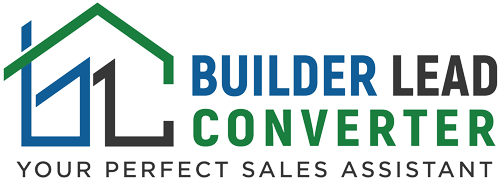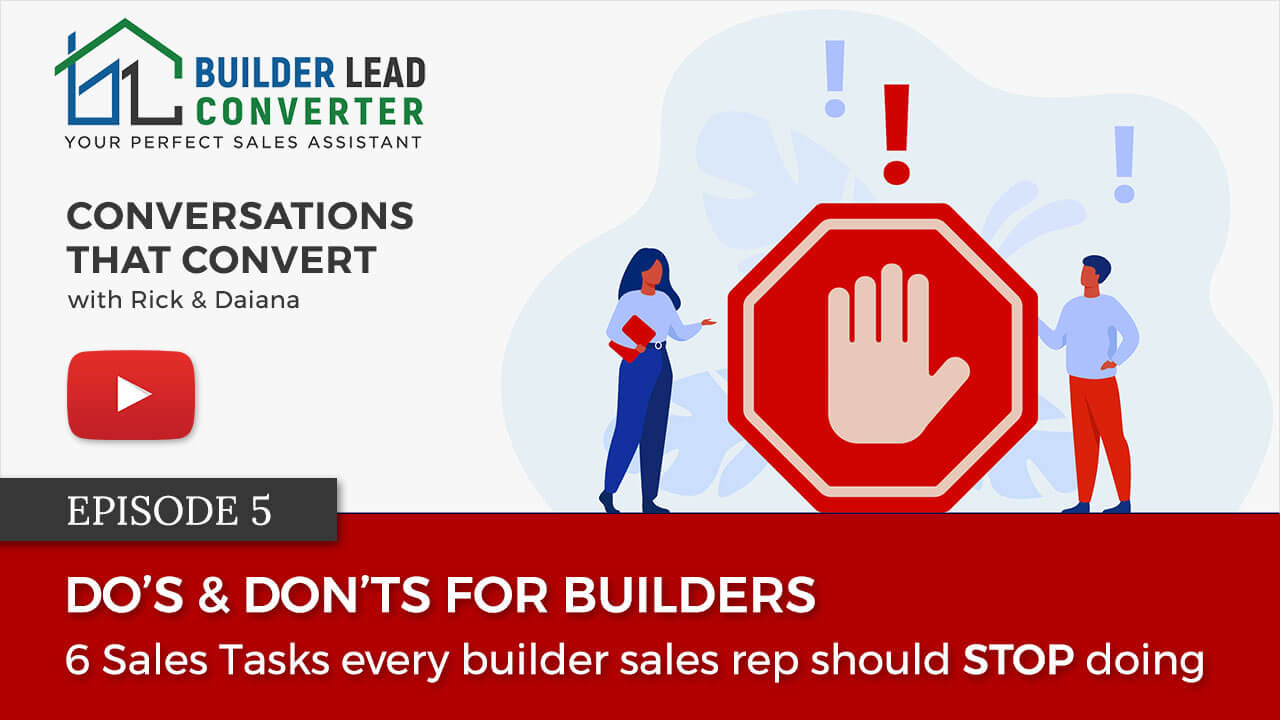Sales reps are the backbone of any remodeler, builder, or home improvement company. They are on the front line meeting with potential customers as the face of your company. With all this hard work, it’s easy for sales reps to get off track or do things that keep them from reaching their potential.
Today we’ll discuss the top 3 out of the six most common pitfalls that keep sales reps from reaching their potential.
Here’s 1-3 of 6:
- Chasing Bad Leads– we’ll show you how this happens and what you can do about it
- Taking on low-margin jobs– these sneak in when you get a little slow and can KILL your bottom line
- Spending too much time behind the windshield– This is a HUGE mistake and you’ll learn the simple tip to avoid getting into this trap
Watch/Listen to our latest episode below for more detail on removing the things that keep you from selling more jobs.
Try Builder Lead Converter right now and see how we plug your opportunity leaks, capture leads, book appointments and help you increase your average sales price and margins. The only thing you have to lose is sales.
Transcript:
Welcome to Conversations That Convert. Every week, we’ll spend about 10 to 15 minutes tackling relevant lead generation, marketing, and sales topics for remodelers, home improvement companies, and home builders. Conversations That Convert is brought to you by Builder Lead Converter, your perfect sales assistant. And now here’s Rick and Daiana.
Daiana: Hi, hello, and welcome and please let us know you’re here and what business you’re in. And if you have a question or thought, we’ll try to get to you during this episode. And if you’re watching the recording, just please let, let, give us a comment or question, and if we use it in a future episode, of course, we’ll make sure you get the credit. So today’s topic is do’s and don’ts for builders. Six sales tasks, every builder sells, the representative should stop doing so, if you are ready Rick, I’m curious. How are you today?
Rick: Well, I am not sitting in my car. I’m sitting in my office, and we had no idea. Daiana, we were gonna be able to see them, the beautiful interior of your car. You should probably explain, what happened to you today.
Daiana: Yeah. Meaning it was an unexpected surprise for me too, here in Romania. It was just. And, the road just a river came across the street. So we were stuck in traffic for more than three hours. So, the unexpected happened. So here I am joining this, this session, live review. So you, you can see the sun just entering my face, so, yeah.
Rick: Well, we’re glad you’re here and we’re glad you’re okay. So you, you avoided that, that flash flood for sure. You’re right. So today’s topic we’re talking about is sales tax, a sales task every sales rep should stop doing. This is part one of two. We’re gonna focus on three today, and then we’ll get into three next, next week. And, for those of you that don’t know, I spent a lot of time coaching, a lot of years coaching, going back to my first role in sales management in 1999. So, I hate to age myself but 20 plus years in coaching and sales management and hiring salespeople. So this is a topic that I’ve spoken on, in-depth. And Daiana, you also do some coaching, as well. So we’re gonna, I guess, you know, maybe pivot a little bit here and just talk about some, some coaching ideas for you, because this is what you know, what it comes down to is that if you wanna make an impact of change in your business, You really need to start with things that you are doing right now that are really unproductive and Daiana’s gonna, you know, talk about that a little bit more. So before you wanna jump in and start adding something like to make some improvements, we need to clear out some of the mess and take some of these things outta your schedule that you’re doing right now, that are either unimportant or are not urgent. And a couple of weeks ago, in one of the videos, we talked about the four quadrants. So we have things that are important and urgent and that’s where most of us operate. Unfortunately, that’s your fires where you’re trying to just put out your fires each day. Then you have the quadrant where things are important but they’re not urgent. And that’s where we wanna shift to, to operating. And then we wanna either eliminate or delegate things that are urgent, and not important and eliminate things that are not important and, and not urgent. So in order to, to try to get you in the right mindset because I really want you to start thinking differently about this is that we need to have this discussion on what is your time worth. Because none of us in this business get paid by the hour. You know, if we’re an owner-operator, obviously we, our, we get paid based on our margins, if we are a salesperson, typically there’s a commission, maybe a commission plus a percentage of profit. And so we’ve always looked at, well, if I sell this job, I get this many dollars. But what I wanna do right now is I just wanna talk a little bit about, Hey, you know what, how do I determine what is the value of my time? And so I put together this little overlay here and it’s just a little simple calculator. It’s gonna help you do just that. So we’re trying to answer the question here, What is your time worth? So, in order to do this, we need to really understand three things. Number one is what’s the average sales price? So if you sell new homes, you sell improvements, home improvements, or if you sell remodeling, what? What is your average sales price? So for this example, what I want to use is simply $50,000. Oops, that’s 500,000. Sorry. Got one. Too many zeros. Okay. $50,000, and we’re gonna say that we make about 10% commission or our net margins are about 10% and that it takes on average, about 10 hours of our time. 10 hours of direct selling time. And so when we do that, what we come to the conclusion is that when we are working one on one and directly selling with our prospects, our time is worth $500 an hour. Now what I want you to think about is the question how can you do more than $500 an hour of work? So what you have to do, obviously, is start to automate, delegate, and eliminate. And Daiana, you had a couple of thoughts on this.
Daiana: Yes, I have a, a, a sentence that I like. It’s called the Daily Income Producing Activities. It’s, it’s where you pay attention and where you focus your activities on a daily basis. So, income-producing activities are those activities that really bring, will bring profitability to your business. It’s, and the question is where do you spend your time during working hours? Do you spend your time on income-producing activities or do you spend time on other things that you, think are profitable but they’re not profitable? So here the question is, what are those, let’s say top three to five income-producing activities, and then, prioritize them? And my invitation is to do them during working hours. So if you have, let’s say income-producing activities, for example, to build relationships with your customers, or new prospects. Let’s say we have a target of 10, for example, per day, then those 10 calls, and 10 activities should be during working hours. So, and then if you want to present your business to three people, then those activities will be income-producing activities and it’s best to do them during working hours. And of course, maybe you have some follow-ups. So that’s my structure to build relationships to talk with new prospects, and new leads, and then present two or three times your business and then follow up with previous customers or prospects or leads. So that’s a, a formula that we, we consider it’s important maybe to consider and find your own numbers. My suggestion is to think about 10 free, free. So 10 prospects that you build relationships with, then three presentations of your business, and then free follow-ups. And then if you stick to those 10 free, free formulas of income-producing activities, then you can see real growth in your business. And then do the rest, I dunno, maybe you want to write an article or you want to spend some time surfing on the internet or on Facebook. So, you have to ask yourself, are those income-producing activities, and if the answer is yes, just go for it and do them. And so the idea is to focus on those. Find, three to five income-producing activities. You can also borrow this formula 10 free, free and use it and see and test it, see how it works, and then. And, then you can, you can serve on Facebook or on the internet and do whatever you like outside working hours.
Rick: And so Good, good points.
Daiana: What the things, Yeah.
Rick: So I, I would, I would add to that I categorize things. So, and you got into it a little bit, but we came, I had the four P’s. So when, when the four P’s. So number one I wanna focus on prospecting. Number two is preparation. Preparation. That would be for number three P is presenting, so I gotta prepare before I present. And then the last one, the fourth one is partnering. And that’s what you talked about. Partnering. You’re gonna partner with, you have your business, affiliate relationships, and then you have your customers. So if I’m a home builder, one of my business relationships obviously is realtors if I’m a remodeler, I might be networking with interior designers. I might be working, networking with architects, you know, where they’re gonna send me business. So preparation, presenting, prospecting, and partnering. Those are the four categories. Now, one other thing I do wanna touch on here though is that automation is real. And what I mean by this is that you talked about eliminating activities. Okay. Facebook. I mean, there are so many things that we do that are not urgent, not important, that suck up our time and our day. So it takes discipline to do that. So I do have to cut that outta my life. But I do wanna say that automation of necessary tasks is real. You know, one of the things that we do right now is that we have what’s called our lead connector. And our lead connector goes on a website and we can automate the process of not only capturing the lead but doing all the follow-up, scheduling the appointment, and then surveying or starting the initial qualifying, which we’re gonna show you a little bit of here today before we ever talk to that lead. So that allows you to do more of these income-producing activities. So let’s, let’s jump into that and, and talk about, you know, what are these things you should stop doing? You know, number one here, and number one I, you know, things is, is I see a lot of waste of time is chasing bad leads. Chasing bad leads is usually because there’s just not a good process, and as an example, example here, this ties into, automation. I’m gonna go ahead and share my screen again but Daiana, this is something that obviously you and I work on. This is simply an offer. This is, you know, based on a Facebook and a Google ad campaign, but here we start to automate qualifying questions. So you see the first question here is where will your new home be located? So we have lots of different answers about where this particular client is. Service, their service area. But then we also have this other. So number one here, this is a qualification question for us. And if somebody chooses that, we can then take that and call them an unqualified lead. So the second question, of course, is the price point. Here we have the ability to, we can qualify people. So this builder doesn’t do anything below 400,000. So if somebody checks here, we’re gonna automate the process of disqualifying. Now, we don’t completely kick this lead to the curb but what we do, do is we give the information to the client. They can decide then if they wanna follow up with them or if they have enough leads in front of ’em, they’re gonna simply let this one go. And so, Daiana, you and I meet each week and we go through our leads and I mean, how many, what’s the ratio approximately? Like, say unqualified to qualified leads that we see on a weekly basis.
Daiana: I think it’s 80-20 our, our role is from last week. So I think it’s 80 disqualified to 20 qualified.
Rick: Okay. So chasing so, so using that, if I’m chasing bad leads, that means for every 10 leads I get, if I’m following up with eight of those that are unqualified bad leads, I’m wasting my time. That is not income-producing time. What it means is, I’m, I lose the opportunity to follow up with the people, the 20% that are gonna buy. So that’s just one way. Automation can make life a whole lot easier for a salesperson where you can be doing more $500 an hour work, you know, versus the work where you, you’re making $5 an hour, you know, or, or, or, or less. And we just wanna focus you on those income-producing activities. All right, so the next stop doing the task is too low of a sales price. We shot a video the other day. I think it was episode two or episode three but we talked about, you know, how you increase your average sales price and margins. And one of the things we said is you have to build a league lead backlog. So when you have too low of an average sales price, it usually means that you are taking on business that you should not. So case in point, I was talking to a builder in Florida, earlier this week, who does home improvement, primarily design-build, remodeling for kitchens and bathrooms, and I was asking about his margins. And he said, Well, you know, normally they’re pretty good, but right now we’re doing a job that’s not so good. He goes, We’re just doing it cuz you know, it’s cash flow. We just gotta keep some dollars coming in the door. And so immediately, you know, this is the, unfortunately, the consequence of not having a good lead backlog is that instead of being able to sort through the 20% that are actually good leads, where you’re gonna get paid, what you’re worth, is that you now gotta take on some of those bad leads where it’s price, price, price. You’re giving up margin just to try to keep some cash flow coming in, in the door. Now I wanna show you another example here of how you would build that lead backlog. This is another client and they do a lot of Lakeshore homes. So anytime you have an area that’s got low inventory, high demand, low inventory. And what I mean by, and what I mean by that is low inventory as far as housing or there’s high demand for a service that you offer. So inventory levels of existing homes are that’s helpful for home builders. And if you have high demand, such as home improvement in your geographic area for homeowners, that’s a boom for remodelers and home improvement companies. So if you see this, this right here, this is something that says, Hey, received notifications on new lake shore opportunities. There’s a high demand for this area. There’s low inventory. And so what this allows this particular village to do is simply start building the lead backlog of new Lakeshore opportunities. And they categorize all these leads for Lakeshore opportunities, and then when something comes up, they can right away reach out to these folks. And they can pick and choose the 20% that are ready to move forward and pay them for what they’re worth for that opportunity. So that’s this one idea to build a lead backlog. It really, it’s gonna vary based on your business type and also, you know, your geographic location but that is a very effective strategy and they get several leads per week just for that one particular item. And then the last thing we wanna mention is in the stop doing is too much windshield time. And this comes down to simply poor phone qualifying. Too often we get a lead-in, and we don’t qualify ’em properly. We get into our car and we’re going out and looking at their home site, we’re gonna go look at their home, look, take a look at the job. We might spend 30 to 60 minutes driving there, another 30 to 60 minutes looking at the job, and another 30 to 60 minutes going back. Then we may be presenting, putting together a pricing package or an estimate for them, and then we’re gonna present it to ’em. So we can waste hours, behind the windshield instead of when we’re focusing on the wrong leads, so that phone qualifying becomes so, so important, and that’s just having a good script asking the right questions, and then being bold enough to say, to say no. The other thing that I see, is too big of a geographic area. So if you are serving too big of a geographic area and it’s taken you 30 plus minutes, 45, 60 plus minutes to drive to your job site, if you’re not making the margins you wanna make you’re, you’re spending too much time behind the windshield. So there’s usually, this is usually indicative of a couple of things. Number one, you’re not specialized enough and you’re spread too thin. Number two is, is simply that you are too specialized and you’re in, and then you’re trying to only find the clientele that is after that particular product or service that you offer. So there’s that fine line thereof being a specialist but not being hyper-specialized. So you have to have such a large geographic area in order to sell your product or, or services. And today, right now, you know, a lot of remodelers and home builders and home improvement companies, you have a real opportunity to bundle services because it is so hard to find good people that will actually respond to leads. So what can you do? What’s the takeaway from today before we jump into next week’s show is you can go ahead in this lead connector tool where you can get in to start automating some of those mundane tasks of following up and chasing those bad leads. You can start automating that and taking that off of your plate. So take those, which is typically important and urgent, so you can take that off of your plate so can focus on more of these important but not urgent activities in order to start growing your business the way that, that you want to grow it. Daiana, any final thoughts from you?
Daiana: Those are amazing news. Where, where can, can I find this lead connector tool?
Rick: Good. Wow. What a question! You’re gonna find it in the comments section below here if you’re on Facebook.
Daiana: Okay.
Rick: And then on YouTube, it’s gonna be in the description and you can go at, you’re, what you’re gonna do is simply go through what one of your leads would go through. You can test the functionality, see how the automation and the technology work on your phone, and decide if you wanna try it for 30 days for free.
Daiana: Oh, that’s amazing. 30 day. Thanks for sharing all that. And we promised to speak about six, things to stop doing and next week it’s part two. So jump on next week, at the same time, and we will find out the next free sales tasks. Every cell sales representative should stop doing so next time. So until then, take excellent care and talk to you soon.
Rick: And for my brothers and sisters in Christ may the love of the Lord Jesus Christ, the love of God, and the Holy Fellowship of Holy Spirit be with you all. See you next time guys. Bye-bye.






Recent Comments